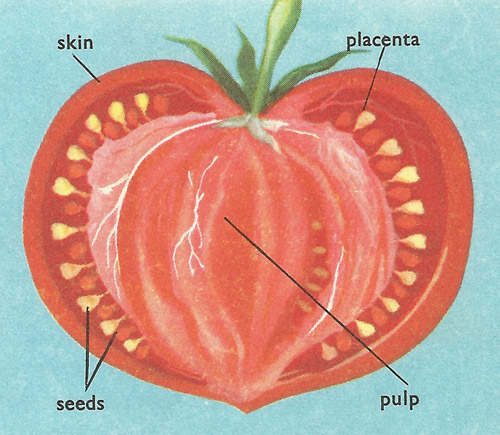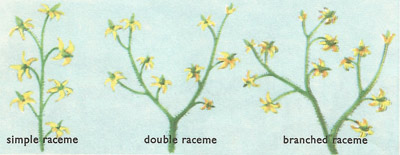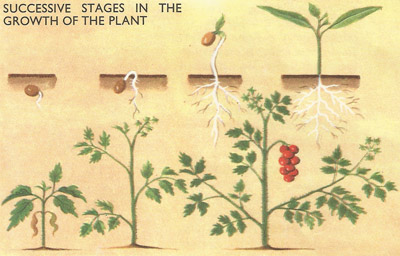tomato

Section of a tomato.

Tomato leaves and flowers.

As in all the Solenaceae, the stamens shed their pollen on to the stigma of their own flower; flowers of this type are called self-pollinating or self-fertilizing.

Successive stages in the growth of the tomato plant.
A tomato is any of a family of plants called the Solenaceae (from the Latin solanum 'nightshade') which includes a number of species with narcotic or poisonous properties, such as thorn apple (Datura), deadly nightshade (Atropa), and henbane (Hyoscyamus). Although they are dangerous if treated careleslly, valuable drugs are extracted from some of these plants – for example, atropine and hyosciamine. Other member sof the family are of great economic importance, such as the potato and the tomato, both of which came originally from America.
The tomato (Lycopersicum esculentum) is a herbaceous plant with a weak stalk, requiring support if it is to stand upright. Although it is always treated as an annual plant in Europe, it is really a perennial – that is, it lasts for more than one year. In their native environment in tropical America, tomato plants grow for several years, and some varieties flower and fruit almost continuously. The leaves are pinnate, composed of 7 to 9 or as many as 11 leaflets.
The leaves, stalk, and other green parts of the plant are densely covered with glandular hairs – that is, hairs with a swelling at the tip. In the tomato plant, the swellings contain a strong-smelling substance which escapes when the plant is handled and the hairs broken, giving the plant its characteristic smell.
Tomato flowers
The flowers of the tomato plant are small and yellow in color. The five petals are joined at their bases (gamopetalous) and the five stamens are clustered round the central pistil. The flowers open successively, not all together, and there are occasionally more than five petals and stamens.
They are arranged in inflorescences or clusters of a type called racemes, which may be simple, double, or branched.
The fruit
The fruit ripens from between 45 and 60 days after the flower is fertilized. The tomato is a soft berry whose shape differes with the different varieties. Its color is due to two pigments, lycopene (red) and carotene (orange-yellow); carotene is found in quantity in carrots. The fruit contains a large number of small, flat seeds.
Cultivation
The tomato is a plant of tropical origin and was cultivated in Mexico and Peru as early as the sixteenth century. It follows that a fairly warm climate is needed to ripen the fruit. Thestem is weak, and stakes are needed to support the plants.
Tomatoes need a hot, dry summer to ripen well outdoors; otherwise, they must be grown under glass. In cooler places, fruit is produced from about May to September, but in warm climates the tomato bears fruit all the year round.
Classification
| division | Spermatophyta (Greek: sperma, seed; phyton, plant) |
| subdivision | Angiospermae (Greek: angeion, vase; sperma, seed) |
class | Dicotyledoneae (Greek: dis, twice; cotyledon, fleshy leaf |
order | Tubiflorae (Latin: tube-shaped flowers) |
family | Solenaceae (Latin: solanum, nightshade |


